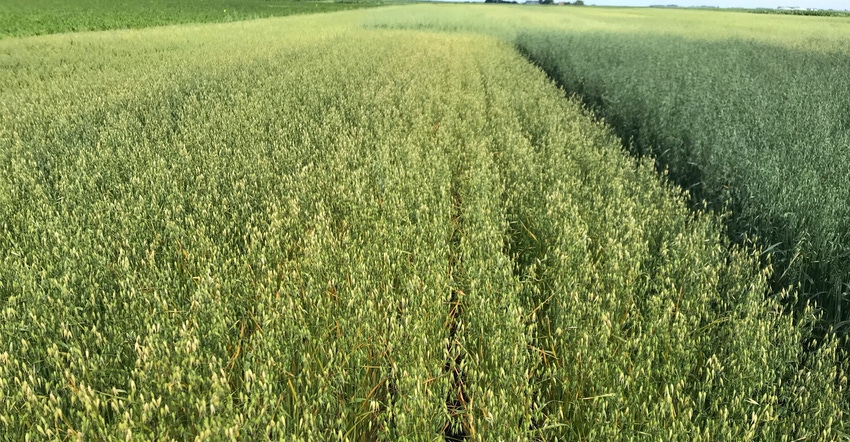December 8, 2020

Careful management and proper choice of variety can make oats a profitable crop, thanks to their low input requirements and beneficial effects on succeeding crops in a rotation. Oats are grown for various uses such as food-grade milling, cover crop seed, livestock feed (grain, hay or oatlage), straw bedding or as a nurse crop for alfalfa.
Because oats are harvested in late July to early August, field management options for the remainder of the season are numerous. These include establishment of a perennial forage or summer cover crop, as well as an opportunity for midseason manure application. In 2020, there were 240,000 acres of oats planted in Iowa, according to USDA’s National Ag Statistics Service. Iowa’s average yield for the year was 78 bushels per acre; the state’s five-year average is 70 bushels per acre.
For the past six years, Practical Farmers of Iowa has helped conduct oat variety trials to aid farmers in decisions surrounding variety selection. In 2020, PFI assisted with the testing of 18 oat varieties at four Iowa State University research farms. Also, two varieties were compared on an organic commercial farm. Stefan Gailans and Lydia English of the PFI staff coordinated these trials.
Choosing right variety
Planting oats before April 15 is recommended for optimal yields in Iowa. This helps avoid exposure to warmer weather during grain fill. Test weight is the most commonly used indicator of grain quality. High test-weight varieties should be chosen by growers who intend to market oat grain to food-grade buyers.
Oat growth is regularly affected by rust and barley yellow dwarf virus. Variety resistance to these diseases should be considered when choosing a variety to plant. Another option is the use of a foliar fungicide applied at Feekes 9 growth stage, defined as flag leaf emerged with ligule visible.
Variety trials were conducted at five locations in 2020:
ISU Northern Research Farm at Kanawha
ISU Ag Engineering & Agronomy Farm at Boone
ISU Northeast Research Farm at Nashua
ISU Southwest Research Farm at Lewis
Ron Rosmann’s organic farm at Harlan
These variety trials build on previous trials conducted at Kanawha, Charles City, Boone and Nashua from 2015 to 2019.
Oat management information is provided with the 2020 variety trial results from each location. No herbicides or insecticides were applied at any location. Entries were screened for crown rust, barley yellow dwarf virus and septoria leaf blight by agronomist Margaret Smith of Albert Lea Seed House and ISU’s Ken Pecinovsky in late June at the Nashua location only.
Key findings of 2020 trials
Data were analyzed by location, and varieties are listed in order of yield performance at each location in the report. Reported yields are corrected for 13% moisture. A “percentage of test average” calculation is included to aid in comparing varieties at each location.
Rainfall and temperature data were accessed from the nearest weather station. Except for Nashua, rainfall in 2020 was well below historical averages. Ratings conducted by Smith and Pecinovsky at the Nashua site on June 29 indicated very low disease incidence.
Across all varieties and sites, the average oat yield was 121 bushels per acre. A variety named Saddle had the highest yield at three of the four ISU research farms.
Streaker, a hull-less variety, scored the highest test weight at each location (greater than 42 pounds per bushel). Three hulled varieties — Sumo, Shelby 427 and Rushmore — made food-grade test weight specifications at three of the four research farms. A test weight of 38 pounds per bushel is the standard minimum many food companies require before dockage is applied. A test weight of 36 pounds per bushel is a minimum that processing facilities can use for food-grade milling.
Yield results, disease ratings and other information about each variety in the 2020 trials are available online. To read the complete report, visit practicalfarmers.org.
English is strategic initiatives coordinator for Practical Farmers of Iowa.
Source: PFI, which is solely responsible for the information provided and is wholly owned by the source. Informa Business Media and all its subsidiaries are not responsible for any of the content contained in this information asset.
Read more about:
OatsYou May Also Like




